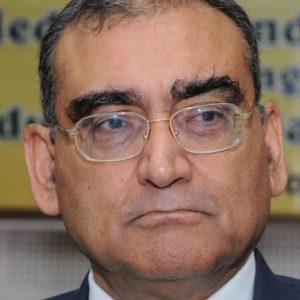
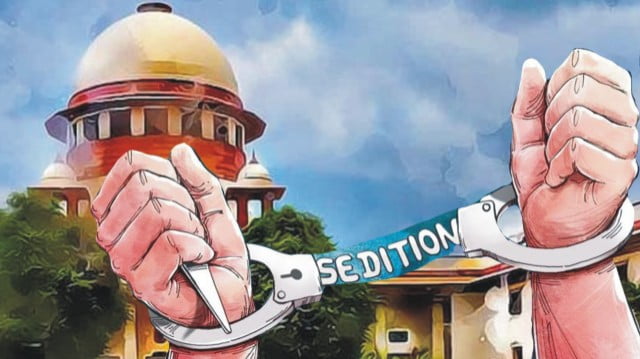
It was heartening to note the oral observations of the Hon’ble Chief Justice of India NV Ramanna about the sedition law in India (section 124A of the Indian Penal Code) during the hearing of a case filed by an army veteran in the Supreme Court.
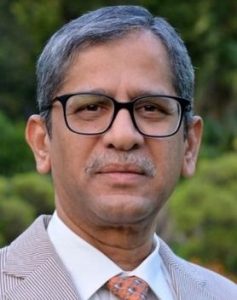
But these were only oral observations, not declaration of the law in the verdict, which will be awaited.
The CJI has rightly pointed out that the colonial law, made by our British rulers to stifle dissent against their rule, is grossly misused today in free India, both by the Central and state governments.
Section 224A IPC states:
“Whoever, by words, either spoken or written, or by signs, or by visible representation, or otherwise, brings or attempts to bring into hatred or contempt, or excites or attempts to excite disaffection towards the Government established by law in India shall be punished with imprisonment for life to which fine may be added, or with imprisonment which may extend to three years, to which fine may be added, or with fine.
Explanation 1.—The expression “disaffection” includes disloyalty and all feelings of enmity.
Explanation 2.—Comments expressing disapprobation of the measures of the Government with a view to obtain their alteration by lawful means, without exciting or attempting to excite hatred, contempt or disaffection, do not constitute an offence under this section. Explanation 3.—Comments expressing disapprobation of the administrative or other action of the Government without exciting or attempting to excite hatred, contempt or disaffection, do not constitute an offence under this section”.
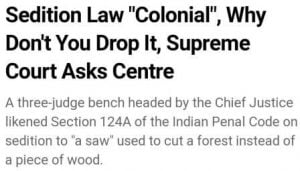 This provision was invoked to arrest Siddique Kappan, a journalist going to cover a rape case in Hathras, Disha Ravi, an environment activist, Sharjeel Imam and other persons criticising the Citizenship Amendment Act, Kanhaiya Kumar and Umar Khalid, etc.
This provision was invoked to arrest Siddique Kappan, a journalist going to cover a rape case in Hathras, Disha Ravi, an environment activist, Sharjeel Imam and other persons criticising the Citizenship Amendment Act, Kanhaiya Kumar and Umar Khalid, etc.
Manipur journalist Kishorechand Wangkhem and an activist were arrested under the National Security Act for saying on Facebook that cowdung and gomutra were not a cure for covid.
Dr Khafeel Khan was arrested under the same law for criticising the CAA. The Bhima Koregaon accused, Varavar Rao, Sudha Bharadwaj, Gautam Navlakha etc were arrested for allegedly having links with maoists, as was Prof Saibaba.
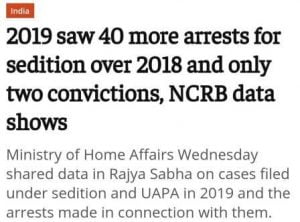 There is frequent and arbitrary use of sedition and preventive detention laws against those who criticise the govt, e.g. cartoonist Aseem Trivedi in Maharashtra, Professor Ambikesh Mahapatra of Jadavpur University in West Bengal, folk singer Kovan in Tamil Nadu, and Kashmiri politicians like Farooq Abdullah and others who were arrested, which make the right to liberty illusory.
There is frequent and arbitrary use of sedition and preventive detention laws against those who criticise the govt, e.g. cartoonist Aseem Trivedi in Maharashtra, Professor Ambikesh Mahapatra of Jadavpur University in West Bengal, folk singer Kovan in Tamil Nadu, and Kashmiri politicians like Farooq Abdullah and others who were arrested, which make the right to liberty illusory.
Scores of such other examples can be given:
Arrests under sedition charges rise but conviction falls to 3%
2019 saw 40 more arrests for sedition over 2018 and only two convictions, NCRB data shows
Sedition cases in India: What data says
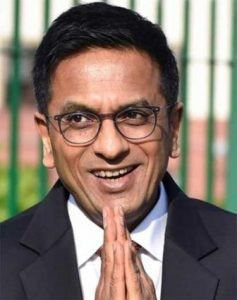
As Justice Chandrachud of the Supreme Court said in a recent speech, in a democracy people have a right to criticise the government, and anti terror laws cannot be used to stifle dissent :
Shouldn’t Misuse Anti-Terror Law To “Quell Dissent”: Supreme Court Judge
But the truth is that the laws are in fact being widely used for this purpose, and people are scared of criticising the government. For instance, people have been arrested for putting up posters criticising the government for mishandling the covid crisis.
The eminent journalist Vinod Dua was charged for sedition for criticising the government ( though the Supreme Court later quashed the charges ) :
In Kedarnath Singh vs State of Bihar, 1965, a Constitution Bench decision of 5 judges of the Supreme Court ( a decision which still holds the field today ), it was held that section 124A IPC does not violate Article 19(1)(a) of the Constitution ( which guarantees freedom of speech to citizens ), but the Court narrowed down the literal meaning of the provision. The Court observed :
“A citizen has a right to say or write whatever he likes about the Government, or its measures, by way of criticism or comment, so long as he does not incite people to violence against the Government established by law or with the intention of creating public disorder”
However, the Court went on to hold :
“The provisions of the section read as a whole, along with the explanations, make it reasonably clear that the sections aim at rendering penal only such activities as would be intended, or have a tendency, to create disorder or disturbance of public peace by resort to violence. As already pointed out, the explanations appended to the main body of the section make it clear that criticism of public measures or comment on Government action, however strongly worded, would be within reasonable limits and would be consistent with the fundamental right of freedom of speech and expression. It is only when the words, written or spoken, etc. which have the pernicious tendency or intention of creating public disorder or disturbance of law and order that the law steps in to prevent such activities in the interest of public order”.
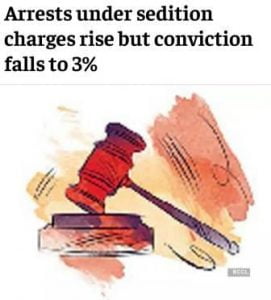 With respect, these observations are vague, and are susceptible to several interpretations. What are activities which ‘intend’, or have a ‘tendency’ to create disorder, or disturbance of public peace and law and order ? Every criticism of the government can be interpreted by the authorities to mean that they intend, or have a tendency to create, disorder or disturbance of law and order. How does this fit in with democracy ?
With respect, these observations are vague, and are susceptible to several interpretations. What are activities which ‘intend’, or have a ‘tendency’ to create disorder, or disturbance of public peace and law and order ? Every criticism of the government can be interpreted by the authorities to mean that they intend, or have a tendency to create, disorder or disturbance of law and order. How does this fit in with democracy ?
I submit that the position needs to be clarified by a larger bench of the Supreme Court.
In Gitlow vs New York, 1925, the US Supreme Court was considering whether an article titled ‘ The Left Wing Manifesto ‘ written by Gitlow, a communist, in which he advocated the violent overthrow of the government, was protected by the First Amendment to the US Constitution which guarantees freedom of speech.
In his dissenting judgment Justice Holmes, the celebrated judge of the US Supreme Court, observed :
“It is said that this manifesto was more than a theory, that it was an incitement. Every idea is an incitement. It offers itself for belief and if believed it is acted on unless some other belief outweighs it or some failure of energy stifles the movement at its birth. The only difference between the expression of an opinion and an incitement in the narrower sense is the speaker’s enthusiasm for the result. Eloquence may set fire to reason. But whatever may be thought of the discourse before us it had no chance of starting a present conflagration.”
Here Justice Holmes was emphasizing his view that suppression and punishment for speech requires an incitement to do a violent act immediately, not in the remote future. This follows the ‘clear and present danger’ test laid down by Justice Holmes in Schenck vs US (1919).
In Brandenburg vs Ohio (1969) the US Supreme Court further clarified the ‘clear and present danger test’ and made it more defined and rigorous. In this decision the Court laid down the ‘imminent lawless action’ test, observing :
“Freedoms of speech and press do not permit a State to forbid advocacy of the use of force or of law violation except where such advocacy is directed to inciting or producing imminent lawless action and is likely to incite or produce such action”.
This decision was followed by the Indian Supreme Court in two decisions in 2011, Arup Bhuyan vs State of Assam, and Sri Indra Das vs State of Assam.
But these decisions are more observed in their breach than in their compliance in India.
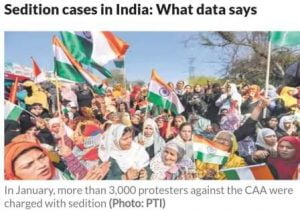 There is another problem which may be noted here. If a person is arrested for sedition or under the NSA or UAPA, and he challenges his detention before the Court, the proceedings usually remain pending for a long time without any decision.
There is another problem which may be noted here. If a person is arrested for sedition or under the NSA or UAPA, and he challenges his detention before the Court, the proceedings usually remain pending for a long time without any decision.
So even if he is ultimately found innocent, he may have to spend a long time in jail. Thus, the Kashmiri politicians detained on 5th August 2019 under the J&K Public Safety Act challenged their detention by filing habeas corpus petitions in the Supreme Court, but these petitions were adjourned again and again without any decision.
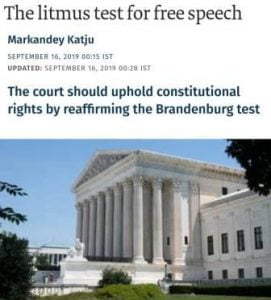 A further problem is that the police often manufactures false evidence at the dictates of their political masters. Thus Safoora Zargar, a pregnant Kashmiri student of Jamia Milia, who had joined the campaign against the CAA was arrested on the very likely trumped up charge of inciting the Delhi riots of February 2020, and was kept in jail for 4 months.
A further problem is that the police often manufactures false evidence at the dictates of their political masters. Thus Safoora Zargar, a pregnant Kashmiri student of Jamia Milia, who had joined the campaign against the CAA was arrested on the very likely trumped up charge of inciting the Delhi riots of February 2020, and was kept in jail for 4 months.
Possibly evidence was also manufactured by the police against the Bhima Koregaon accused and Prof Saibaba, who are still in jail.
I submit that if democracy is to be preserved the time has come when the Supreme Court must resume its role of guardian of the rights of the people, as mentioned in this article. ![]()
Also Read:
Misuse of UAPA – Responsible must not escape punishment
Institute Of Governance Vs Constitutional Courts: Democracy At Its Peril
Watch video:

Disclaimer : PunjabTodayTV.com and other platforms of the Punjab Today group strive to include views and opinions from across the entire spectrum, but by no means do we agree with everything we publish. Our efforts and editorial choices consistently underscore our authors’ right to the freedom of speech. However, it should be clear to all readers that individual authors are responsible for the information, ideas or opinions in their articles, and very often, these do not reflect the views of PunjabTodayTV.com or other platforms of the group. Punjab Today does not assume any responsibility or liability for the views of authors whose work appears here.
Punjab Today believes in serious, engaging, narrative journalism at a time when mainstream media houses seem to have given up on long-form writing and news television has blurred or altogether erased the lines between news and slapstick entertainment. We at Punjab Today believe that readers such as yourself appreciate cerebral journalism, and would like you to hold us against the best international industry standards. Brickbats are welcome even more than bouquets, though an occasional pat on the back is always encouraging. Good journalism can be a lifeline in these uncertain times worldwide. You can support us in myriad ways. To begin with, by spreading word about us and forwarding this reportage. Stay engaged.
— Team PT


Copyright © Punjab Today TV : All right Reserve 2016 - 2024 |